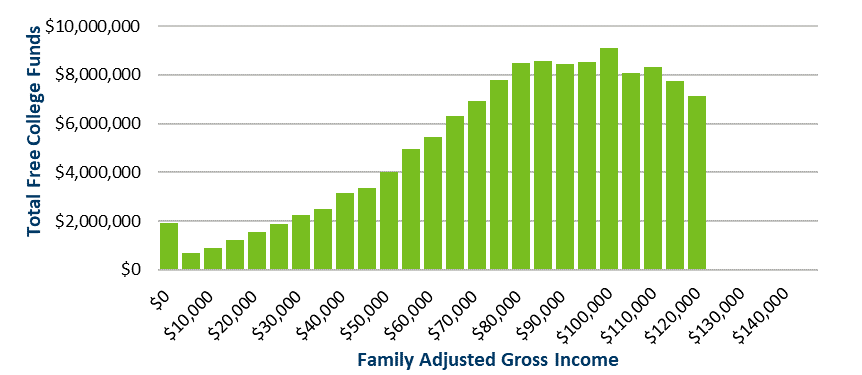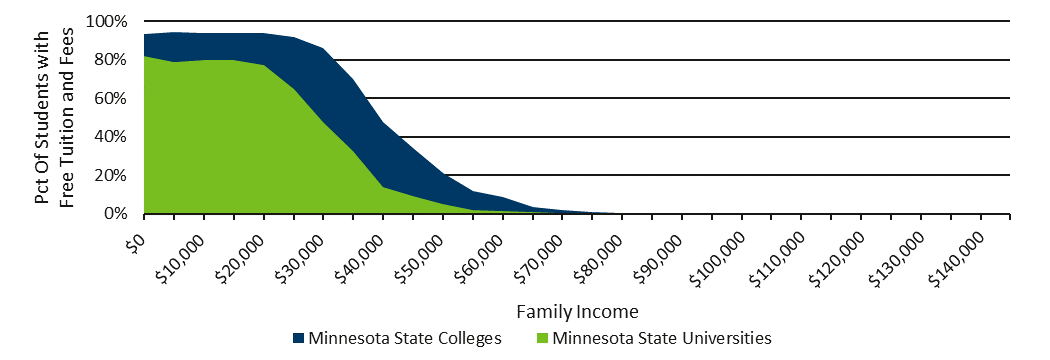“Free College” in Minnesota
The idea of tuition free college has gained popularity among some politicians and state leaders over the past few years. The rising tuition and debt of graduates has been a driving force in these discussions. Minnesota Office of Higher Education staff prepared a brief discussing free college pros, cons, and alternatives Minnesota could adopt to lower tuition costs for students and families. The brief is summarized below.
What is “free college”?
“Free college” programs are generally last dollar scholarship programs that cover tuition for undergraduates after all other grants or scholarships have been applied. Examples of “free college” programs include the Tennessee Promise, the Hawaii College Promise, and the New York Excelsior Scholarship. Although aspects of each “free college” program may vary, plans typically include some combination of the following program components:
- FAFSA completion requirement
- Family income limit
- Eligibility limited to recent high school graduates
- Limits by institution type (e.g. public 2‐year colleges only)
- Full‐time enrollment
- Community service requirements
- Mentoring for students
- Students sign pledges in middle or high school
- Grade point average minimum to receiving funding
- Maximum number of semesters or years during which a student can receive funding
- State residency requirement
- Must work in state after leaving college
Although program language suggests that college is “free” for undergraduates, often these programs cover less than half of the costs to students and their families. “Free college” programs cover tuition, but may not cover fees, and typically do not cover other non‐tuition costs such as books, transportation, and living expenses.
“Free college”: Key considerations
- “Free college” programs target funds to middle income students, not the lowest‐income students.
Total “Free College” Funds by Family, Eligibility Limited to Families with Income <$125,000 and Students Attending Public Institutions

- “Free college” programs targeting students only at one type of institution may impact enrollments in other sectors.
- “Free college” programs require sustained state financial investments.
- Boosting student success hinges on more than just increased financial aid.
Does Minnesota already have free tuition and fees?
The Office of Higher Education analyzed data on tuition and fees, Pell Grants, and Minnesota State Grants for Minnesota resident undergraduates enrolled at a public institution who applied for aid in the 2017‐2018 academic year and projected results forward to the 2019‐2020 academic year.
Yes, for the lowest income students
Of the 137,000 undergraduates enrolled at Minnesota public institutions, approximately 38,000 students (28%) received combined federal Pell Grant and Minnesota State Grant aid that was equal to or greater than the average tuition and fees charged.- Dependent students whose Pell and State Grant awards met or exceeded 100% of tuition and fees included those with incomes $0‐$45,000 at Minnesota State Colleges and incomes $0‐$30,000 at Minnesota State Universities as shown in Figure 8.
- Independent students with children whose Pell and State Grants exceeded 100% of tuition and fees at Minnesota State Colleges included those with incomes $0‐$60,000 and at Minnesota State Universities included those with incomes $0‐$45,000, as shown in Figure 9.
- Independent students without children whose Pell and State Grants exceeded 100% of tuition and fees at Minnesota State Colleges included those with incomes $0‐$30,000 and at Minnesota State Universities included those with incomes $0‐$10,000, as shown in Figure 10.
- The lowest‐income students receive grants in excess of tuition and fees to offset cost of living expenses.
Minnesota Dependent Students Percent Receiving Pell + State Grants Covering 100 Percent of Tuition & Fees by Income, FY 2020 Estimates

How much would “free college” cost in Minnesota?
The cost of any “free college” program depends on the overall design of the program. Overall, the fewer students eligible, the lower the cost of the program. Programs that have less restrictive eligibility requirements and/or cover a wider range of college costs tend to be more expensive.
For the purposes of this analysis, three versions of “free college” programs with different eligibility requirements were chosen to illustrate the costs of a potential “free college” program in Minnesota. The three examples range from highly restricted eligibility and application processes to more broadly defined/accessible programs. The programs modeled here capture the primary aspects of the original program, while incorporating elements that would allow the program to better fit the higher education needs of Minnesotans. The three examples chosen for this analysis are: Hawai'i Promise (less restrictive), New York's Excelsior Scholarship (moderately restrictive), and Tennessee Promise (more restrictive).
Read more about examples of “free college” program options, costs, and other information about financial aid in the full brief.
Note: documents in Portable Document Format (PDF) require Adobe Acrobat Reader 5.0 or higher to view.
Quick Links
- Why College?
- Explore Your Interests & Careers
- Prepare at School
- Summer Academic Enrichment Program
- The Many Ways to Earn Credit for College
- Recommended High School Classes & Graduation Requirements
- Advice for Students with Disabilities
- Succeed as an Adult Student
- Useful College Prep Resources
- Minnesota Goes to College!
- Collecting Data from Minnesota Postsecondary Institutions
- Campus Financial Aid Administrator Resources
- Campus Student Enrollment Reporting Resources
- Ordering Materials for Your Students
- Supplementing Your College Counseling
- Early Awareness Efforts
- Student Homelessness in Higher Education Resources
- Shared Library Resources
- MN FAFSA Tracker
- Campus Sexual Violence Prevention and Response
- Statewide FAFSA Filing Goal
- MyHigherEd
- Online Applications
- About Financial Aid
- What Does College Cost?
- Tips for Lowering the Cost of Higher Education
- Institutional Payments
- Financial Aid You Don't Repay
- Financial Aid You Must Repay (Student Loans)
- Financial Aid You Earn
- Military Service Education Benefits
- Reduced Out-of-State Tuition Options
- Education Tax Benefits
- Public Service Loan Forgiveness
- Ready, Set, FAFSA!
- North Star Promise
- Minnesota Paramedic Scholarship
- Data Maps and Infographics
- Educational Attainment Goal 2025
- Minnesota P-20 Statewide Longitudinal Education Data System
- Minnesota Measures
- Student Enrollment Data
- College Readiness & Participation Data
- Degrees, Graduation Rates, Attainment & Outcomes
- Tuition & Fees Data
- Student Health and Safety
- Financial Aid Data & Trends
- Institution and Data Search
- Transfer Students
- Research Reports
- A-Z Data Table Index
- Postsecondary Funding
- Special Student Populations
